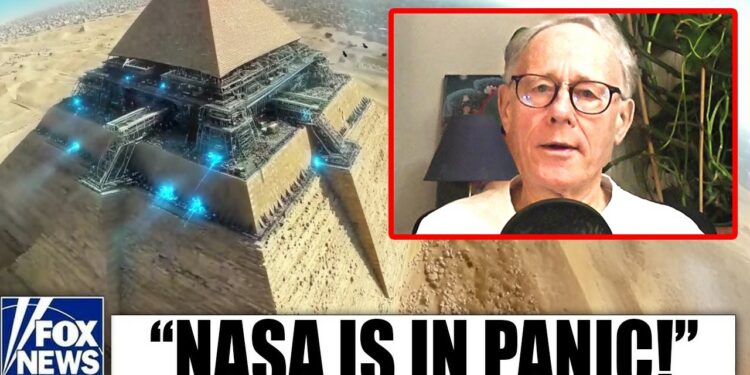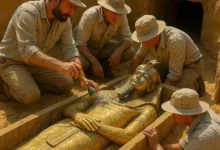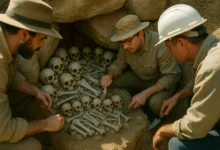“Horror Beneath the Pyramids! Alien Mega-Tomb Unearthed – Experts Flee in Terror from Cursed Discovery!”

Recent breakthroughs using advanced radar technology have uncovered massive structures hidden beneath Egypt’s Giza pyramids. These unusual, deliberate formations have sparked intense speculation about their purpose. Are they natural geological features, or do they hint at ancient knowledge yet to be fully understood?
Shifting Perceptions of the Giza Pyramids
For centuries, the Giza pyramids were viewed as elaborate tombs built to house the remains of ancient Egyptian pharaohs. This narrative was supported by physical evidence from many pyramid complexes, which contained mummies, funerary items, and inscriptions honoring royalty. The Great Pyramid of Giza, in particular, was long considered the final resting place of Pharaoh Khufu and a pinnacle of Old Kingdom architecture, as described in countless history classes, documentaries, and museum exhibits. However, new scans and surprising discoveries are complicating this traditional story.
Some experts now question whether the Great Pyramid was solely—or even primarily—a burial site. A key issue is the absence of typical royal tomb markers within the pyramid. The so-called King’s Chamber contains a plain granite container, but no inscriptions confirm it as Khufu’s sarcophagus, and no mummy or funerary goods have been found. While earlier theories attributed this to ancient robbers stripping the interior, many scholars now doubt this fully explains the pyramid’s stark differences from other Egyptian tombs, which often feature extensive inscriptions and decorations.
Advanced radar and imaging technologies have revealed unexpected chambers, voids, vertical shafts, and intricate subterranean features beneath the Giza Plateau. Some reports claim radar Doppler tomography has detected cylindrical structures extending hundreds of meters below the pyramid, with networks possibly stretching up to 2 kilometers underground. While on-site excavations have yet to fully confirm these findings, the claims alone have reignited scholarly and public interest. The possibility of vast tunnels or chambers far below the surface challenges how we view the entire site.
Traditionally, only a few features were emphasized: the King’s Chamber, the Queen’s Chamber, and an unfinished subterranean chamber. However, if extensive corridors or spiral wells exist deep in the bedrock, it suggests the Great Pyramid’s purpose, design, or even age may not align with mainstream accounts. Additionally, the use of specialized materials like limestone and granite, combined with the pyramid’s precise alignment to cardinal directions, electrical conductivity, and acoustical resonance, fuels hypotheses about functions beyond a simple tomb. While these ideas remain outside mainstream archaeology, they reflect a growing shift away from viewing the pyramids as mere burial sites, suggesting centuries of advanced engineering may have served a more complex purpose.
Why the “Tomb-Only” Explanation Is Challenged
The tomb theory initially seemed logical, as many pyramids from various eras contained remains, funerary goods, or wall drawings depicting the pharaoh’s journey to the afterlife. During the Old Kingdom, large state-sponsored monuments symbolized centralized power and devotion to the king, so historians categorized all pyramids, including the Great Pyramid, as tombs despite limited direct evidence of a burial. Over time, however, inconsistencies emerged.
Unlike later royal tombs filled with lavish murals and hieroglyphic prayers, the Great Pyramid’s interior, particularly the King’s Chamber, is remarkably plain. The granite container’s function is debated, and the lack of inscriptions, statues, or markers honoring Khufu’s rule is puzzling, especially given the pharaoh’s vast resources. Smaller tombs from the same period are often richly decorated, making the Great Pyramid’s austerity stand out.
The pyramid’s engineering also raises questions. Aligned to true north with extraordinary precision, its massive limestone and granite blocks are fitted with near-perfect accuracy, and its internal corridors reflect advanced geometric knowledge. Viewed in isolation, the Great Pyramid appears as a unique megaproject that transcends typical tomb designs. Some propose it may have stored knowledge or harnessed natural energy, though these ideas remain speculative.
While many Egyptologists maintain the pyramid’s funerary purpose, citing looting or incomplete use by Khufu, skeptics note that other looted complexes, like those at Saqqara or the Valley of the Kings, still retain abundant references to the deceased. Recent scans suggesting hidden voids or vast subterranean structures further challenge the tomb narrative. If confirmed, these features would question whether the pyramid was solely a pharaoh’s resting place or served a broader, yet-to-be-understood role.
Skeletons at Tombos and Burial Hierarchies
Excavations at Tombos in modern-day Sudan offer a fresh perspective on pyramid burials. This site, featuring small mud-brick pyramids from the period of Egyptian rule over Nubia, revealed skeletons of individuals who led physically demanding lives, showing signs of heavy labor, wear, and strain. This was unexpected, as archaeologists traditionally assumed pyramids were reserved for royalty or high-status individuals. The discovery suggests that pyramid burial customs may have been more varied than previously thought.
At Tombos, the presence of lower-status individuals in pyramid-style tombs implies that burial practices could blur the lines between royal and community tombs. These burials might reflect local customs or a system where minor officials or workers shared prestigious burial methods, possibly to serve higher-status occupants in the afterlife. While Tombos’ scale is far smaller than Giza’s, it challenges the assumption that the Great Pyramid was exclusively for Khufu. If smaller pyramids accommodated diverse burials, Giza’s purpose may also be more complex. For instance, the largest pyramid at Tombos belonged to Pharaoh Siamun of the 21st Dynasty, but smaller structures and collapsed subchambers suggest multiple burials over time, hinting at varied uses of the pyramid form.
Ground-Penetrating Technology
Traditional excavation at Giza is limited due to the site’s historical and political sensitivity, with authorities often opposing invasive methods to avoid structural damage. Instead, advanced remote sensing technologies—radar, satellite imaging, muon detection, and thermal scanning—have become essential. Muon detection, which tracks cosmic ray particles passing through matter, revealed a mysterious void inside the Great Pyramid several years ago. Debate continues over whether this is a construction gap or a significant chamber, as permits for direct exploration were denied.
More recent claims, based on radar Doppler tomography, suggest detailed 3D images of subterranean structures, including vertical wells, spiral paths, or large cubic spaces extending hundreds of meters deep. Some reports propose these networks connect the pyramids of Khufu, Khafre, and Menkaure, stretching far beyond their bases. Such depths—potentially 600 meters or more—would represent an extraordinary engineering feat for any ancient culture. Proponents argue this points to advanced technology or a lost civilization, while critics caution that these could be geological features like faults or water channels, requiring physical confirmation.
These findings underscore how much remains unknown about the Great Pyramid. If validated, the scale and complexity of these subterranean structures could challenge established views of Old Kingdom practices, suggesting a purpose beyond a simple tomb.
Debates Around Subterranean Design
Reports of vast corridors or cylindrical formations beneath Giza have captured attention, often tied to synthetic aperture radar data from private satellite companies. One claim describes eight vertical wells, some hundreds of meters deep, arranged in rows beneath the Great Pyramid, with massive 80-meter-wide cubic formations possibly linked by spiral walkways. Such designs far exceed the scope of typical burial shafts, even in major New Kingdom tombs. If confirmed, they would challenge the engineering capabilities attributed to ancient dynasties.
Theories about these structures range from practical to speculative. Some suggest the builders used natural caverns for storage or rituals, later sealing them. Others propose a pre-flood advanced civilization or reference esoteric texts like the Halls of Amenti, which describe hidden libraries beneath Giza. While mainstream archaeology dismisses these ideas for lack of evidence, the extraordinary nature of the findings makes simple explanations difficult.
Energy Theories: Nikola Tesla and the Great Pyramid
Another intriguing hypothesis suggests the Giza pyramids functioned as power centers, possibly even wireless energy plants, drawing parallels to Nikola Tesla’s early 20th-century experiments with global electricity transmission. Tesla’s Wardenclyffe Tower aimed to harness Earth’s resonance for energy distribution, and some believe the Great Pyramid’s design—its limestone insulation, quartz-rich granite, and precise cardinal alignment—could have served a similar purpose. The pyramid’s position over potential aquifers might have generated vibrations, amplified by its materials and shape.
The so-called air shafts in the King’s and Queen’s Chambers are said to align with frequencies that resonate at specific pitches, with some likening the structure to a giant conductor topped by a gold-plated capstone. Claims of copper wiring, allegedly found and removed, fuel speculation about an electrical system. Critics argue these ideas rely on unverified assumptions, noting that cited frequencies (e.g., 432 Hz) may not match the pyramid’s measurements and that no clear evidence of a generator exists. Still, the theory’s appeal lies in offering an alternative explanation for the pyramid’s complexity, geometry, and lack of funerary content.
Materials and Resonant Properties
The Great Pyramid’s materials, particularly Aswan granite with quartz crystals capable of piezoelectric effects, and dolomite, which may enhance conductivity, spark curiosity. Transporting massive granite blocks hundreds of kilometers suggests a purpose beyond mere construction, as local limestone was more accessible. Audio tests in the King’s Chamber reveal distinct ringing tones, leading some to propose it functions as a Helmholtz resonator, amplifying vibrations. While mainstream scholars attribute these effects to structural choices, alternative researchers argue the granite was tuned to specific frequencies, hinting at a deliberate acoustic or energy-related function.
Subsurface Water, Earth Forces, and Architecture
The Giza Plateau’s geology suggests subterranean aquifers, and local traditions mention tunnels or wells beneath the pyramids and Sphinx. If scans confirm significant water channels, they could support theories that the pyramid harnessed energy through water-induced vibrations, amplified by its materials and design. Some propose the rumored vertical shafts are water conduits, part of a sophisticated system requiring advanced engineering. Whether attributed to a lost civilization, supernatural guidance, or underestimated ancient knowledge, such feats challenge simplistic explanations of pyramid construction.
Mystery Texts and Esoteric Narratives
Esoteric texts like the Emerald Tablets or references to Thoth the Atlantean suggest a pre-dynastic or Atlantean civilization built Giza with advanced knowledge, possibly storing it in a “Hall of Records” underground. While dismissed by mainstream scholars, these ideas persist due to the pyramid’s anomalies and stories of floods in various cultural traditions. Some Christian interpretations see these findings as supporting biblical accounts of pre-flood civilizations, while others propose extraterrestrial or interdimensional influences. The debate bridges archaeology, mythology, and questions about human history, fueled by the possibility that deep excavations could reveal evidence aligning with these narratives.




